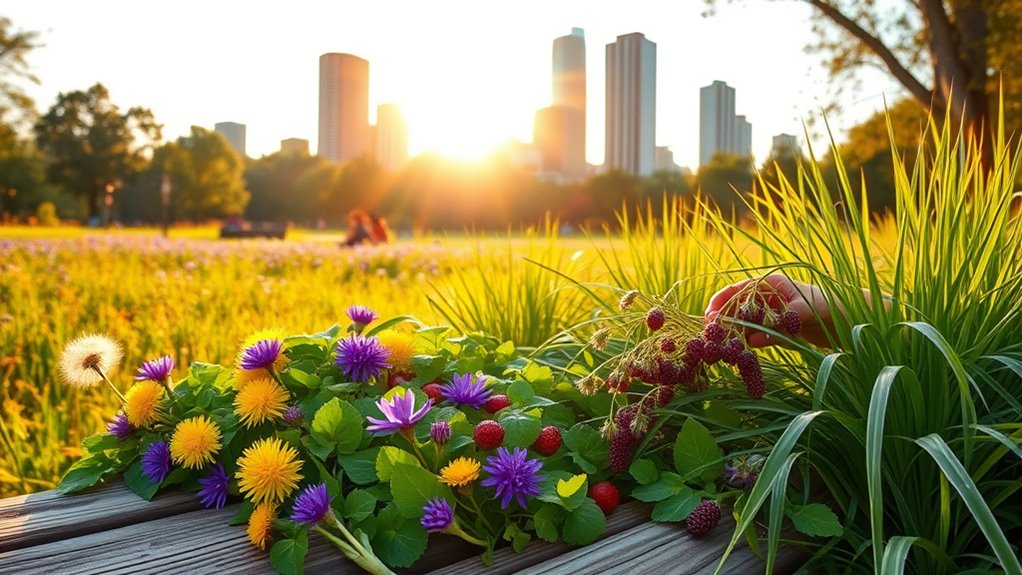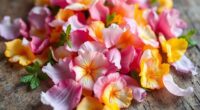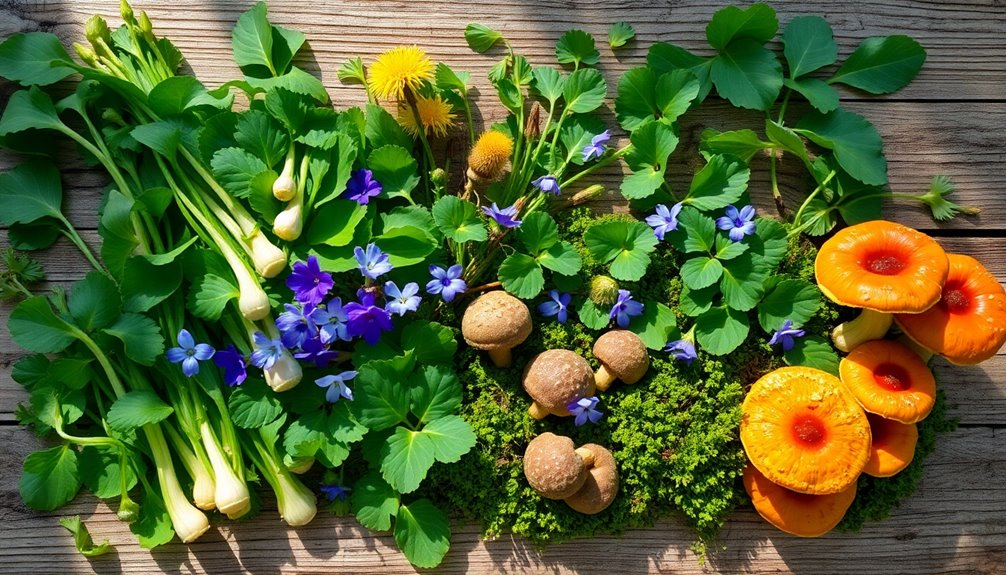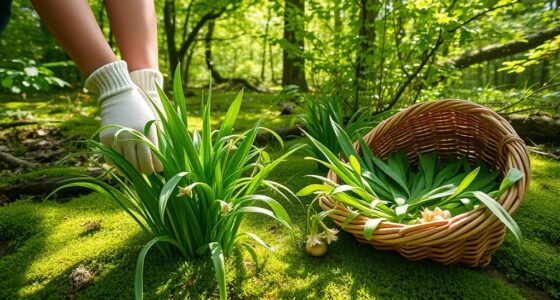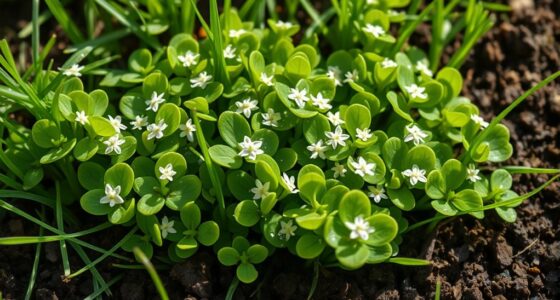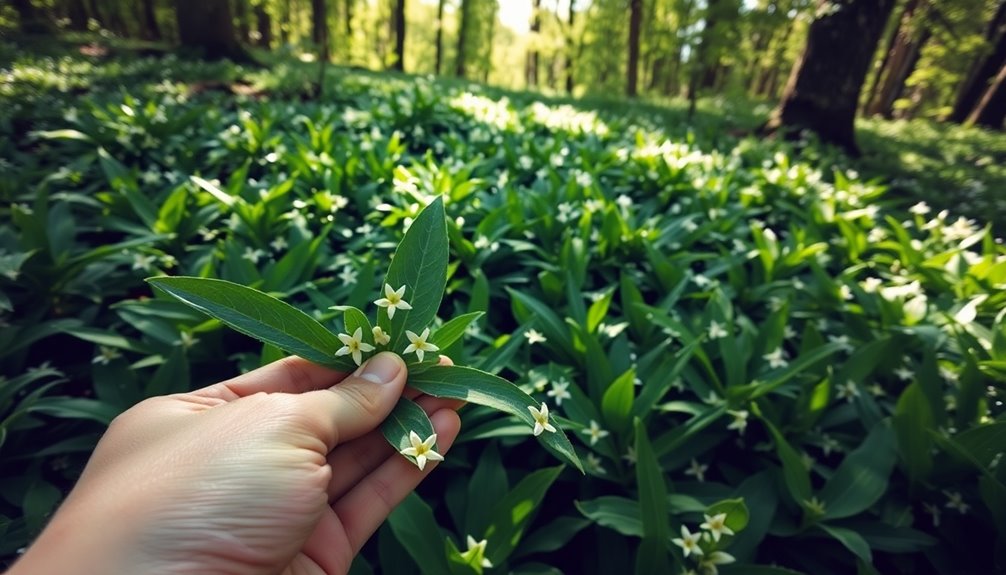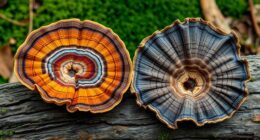In your city park, you can find edible plants like dandelion greens, purslane, chickweed, and herbs such as mint, basil, and chives growing near pathways or neglected spots. Watch for wildflowers like violets and calendulas, and keep an eye on berries for safe picks, ensuring proper identification to avoid toxic lookalikes. Practice safe foraging by avoiding polluted areas and using tools properly. Explore how seasonal changes influence what’s available and learn how to harvest sustainably if you want to maximize your urban foraging skills.
Key Takeaways
- Learn to identify common edible plants like dandelion, purslane, and chickweed in parks and urban cracks safely.
- Always forage from pollution-free areas, avoiding plants near busy roads or contaminated sites.
- Use field guides and tools to accurately distinguish edible plants from toxic look-alikes.
- Harvest sustainably by taking only what you need and respecting plant growth to support urban ecosystems.
- Check local regulations and park signage to ensure responsible and legal foraging practices.
Recognizing Common Edible Greens in Urban Settings
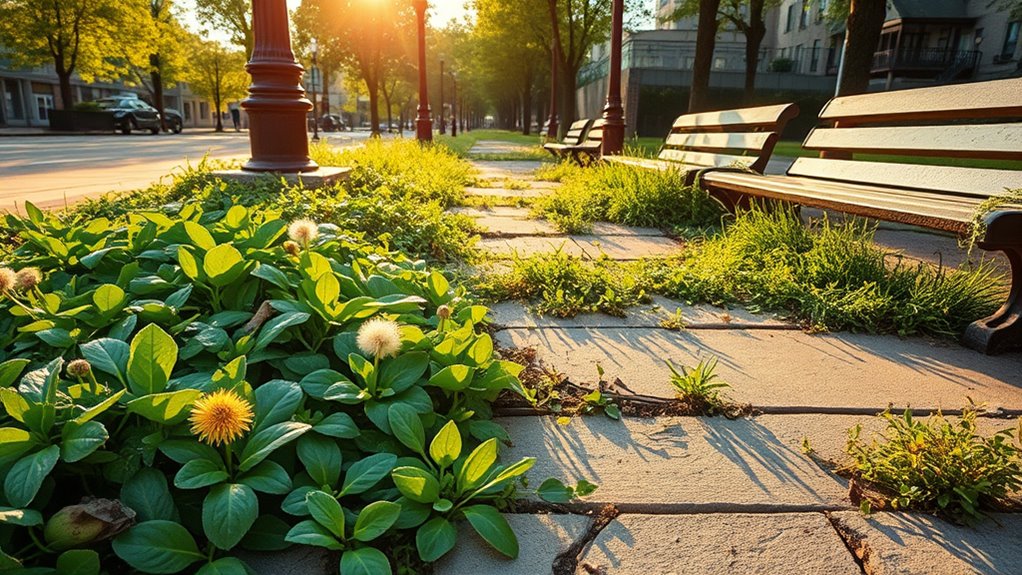
In urban environments, many common greens are easy to identify and often overlooked as food sources. By practicing urban plant identification, you can spot edible greens like dandelion, purslane, and chickweed growing in parks, cracks in sidewalks, or vacant lots. These plants are typically hardy, fast-growing, and recognizable by their distinctive leaves and growth habits. Following city foraging guidelines is essential—always ensure you’re collecting from pollution-free areas and avoid plants near busy roads or contaminated sites. Learning to distinguish these greens from non-edible or toxic plants is crucial for safe foraging. With keen observation and proper knowledge, you’ll find that many familiar-looking plants are not only edible but also nutritious additions to your urban foraging toolkit.
Identifying Wild Berries and Fruits Safely
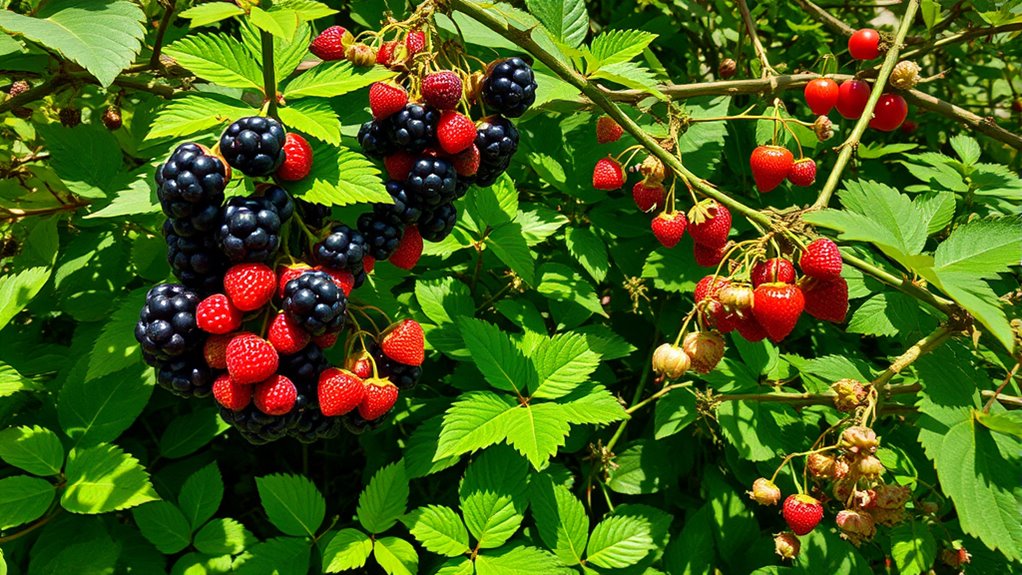
When foraging for wild berries and fruits, you need to learn how to spot the edible ones quickly and accurately. It’s essential to recognize common safe varieties and distinguish them from toxic lookalikes. By paying close attention to details, you can enjoy foraging without risking your health. Consulting foraging guides can further improve your ability to identify safe plants accurately.
Spotting Edible Berries
To safely spot edible berries, you need to learn how to distinguish them from toxic look-alikes, as many wild berries share similar shapes and colors. Urban berry identification involves paying close attention to details like leaf shape, stem texture, and berry clusters. Use safe foraging tips such as checking for signs of pests or mold, and verifying that the berries grow in familiar patterns. Always observe color variations, as some berries change hue when ripe, and note their environment—edible berries often grow in specific habitats. Remember, even if a berry looks appealing, it’s vital to be confident in your identification before consuming. Developing your eye for edible berries ensures a safer foraging experience in your city park. Additionally, understanding foraging safety can help prevent accidental ingestion of toxic plants.
Avoiding Toxic Lookalikes
While learning to identify edible berries is important, recognizing and avoiding poisonous lookalikes is equally essential for safe urban foraging. Many toxic plants mimic the appearance of safe berries, making plant identification vital. Before harvesting, compare key features like leaf shape, stem color, and berry cluster arrangement to trusted guides or apps. Poisonous lookalikes often have subtle differences, such as a different leaf texture or stem hue. Never rely solely on color, as it can be deceptive. When in doubt, discard unfamiliar berries; consuming poisonous lookalikes can lead to serious health issues. Practice cautious plant identification, and always err on the side of safety. Remember, if you’re unsure about a berry or fruit, it’s better to skip it than risk poisoning. Incorporating *mindfulness* techniques into your foraging practice can help you stay attentive and make safer choices.
Herbs and Flowers That Grow in City Parks

City parks often host a variety of herbs and flowers that you can identify and enjoy. Some herbs are common and safe to eat, while many wildflowers offer colorful options that are also edible. Remember to follow safety tips to avoid confusion and potential risks when foraging in urban areas. Familiarizing yourself with foraging techniques can help ensure a safe and rewarding experience.
Common Edible Herbs
Have you ever noticed the vibrant herbs and flowers thriving in city parks that you might overlook? These common edible herbs are perfect for urban foraging, and learning to identify them boosts your plant identification skills. You can find herbs like basil, mint, and chives growing in neglected corners or near pathways. Use this table to help recognize these herbs easily:
| Herb | Appearance | Edible Part |
|---|---|---|
| Basil | Green leaves, aromatic scent | Leaves |
| Mint | Square stems, fragrant leaves | Leaves |
| Chives | Thin, hollow green stalks | Leaves |
| Dandelion | Bright yellow flower, jagged leaves | Flowers, leaves |
Always verify plant identity before harvesting, and remember, urban foraging is safest when you can confidently identify edible plants. Additionally, understanding electric dirt bike performance can inspire eco-friendly transportation options for city explorers.
Colorful Wildflowers Edibility
Many vibrant wildflowers bloom throughout urban parks, adding color and life to city landscapes. Some of these colorful wildflowers feature edible petals you can enjoy in salads, teas, or as garnishes. Flowers like pansies, violets, and calendulas often grow wild and are safe to eat when properly identified. Their bright, edible petals bring not only visual appeal but also subtle flavors to your foraged meals. Always confirm you correctly identify these wildflowers before consuming, as some may resemble toxic varieties. Harvest petals from plants growing away from polluted areas or heavily trafficked paths. Incorporating edible wildflowers into your foraging routine allows you to enjoy nature’s colorful offerings while adding variety to your diet. Remember, proper identification and moderation are key to safe, enjoyable foraging.
Foraging Safety Tips
While foraging in urban parks can be rewarding, it’s essential to prioritize safety to avoid poisonous plants. Always identify plants carefully before harvesting, as some herbs and flowers can be mistaken for safe options but are actually toxic. Familiarize yourself with common poisonous plants in your area and learn how to spot them. Avoid foraging without proper knowledge or permits, as some parks require foraging permits to ensure safety and sustainability. Never consume plants unless you’re 100% sure of their identity, and consider consulting a local expert or foraging guide. Keep your foraging activities focused on safe, legal plants, and respect park regulations. Taking these precautions helps guarantee your urban foraging experience remains enjoyable and safe. Additionally, understanding Angel Numbers related to love and spiritual guidance can enrich your connection to nature and your personal growth during foraging adventures.
Seasonal Changes and What They Mean for Foragers
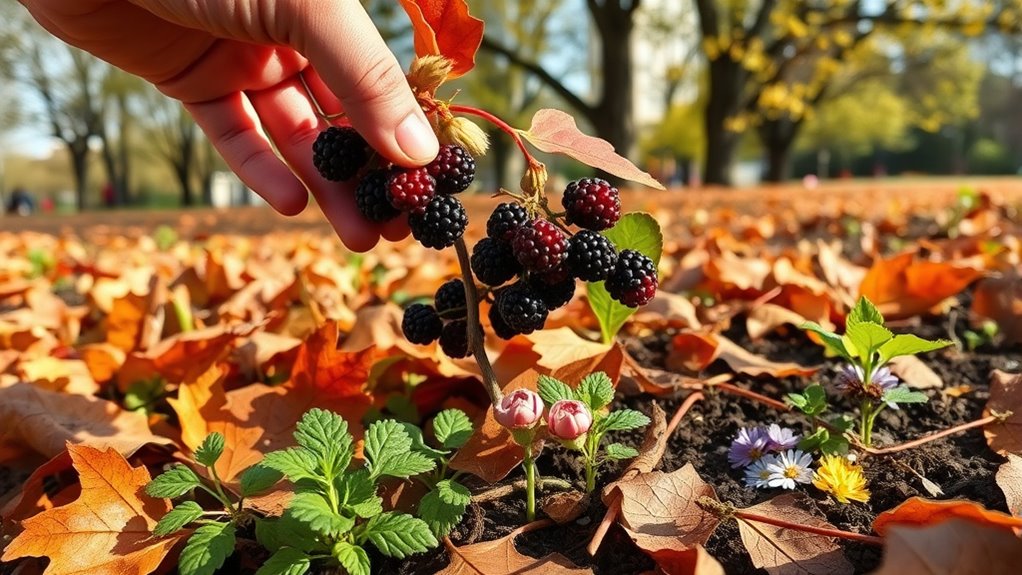
As the seasons shift, the availability and variety of wild edibles in urban environments change dramatically, directly impacting foragers. Understanding seasonal foraging helps you identify which plants are at their peak and when they become scarce. Urban plant cycles vary with weather and daylight, influencing when certain herbs, berries, or greens are best harvested. In spring, you might find young shoots and flowering plants, while summer offers ripe berries and lush foliage. Fall signals a bounty of nuts and root vegetables, and winter may limit your options but reveal hardy greens or evergreen edibles. Keeping track of these seasonal changes guarantees you’re harvesting safely and sustainably. Additionally, being aware of plant identification and potential hazards is crucial for safe foraging. By observing urban plant cycles, you maximize your foraging success and respect the natural ebb and flow of city flora.
Tools and Techniques for Safe Urban Foraging
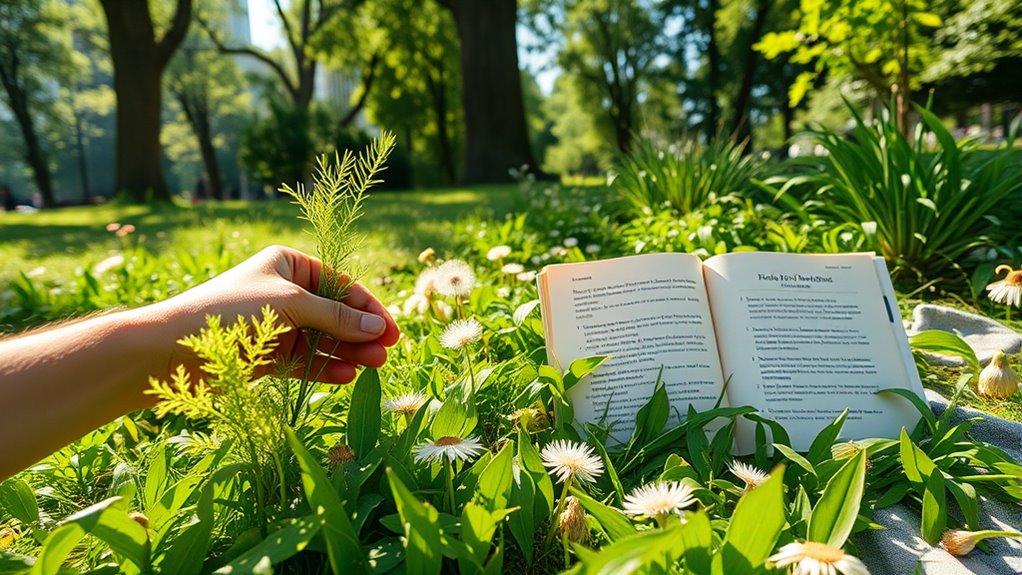
Equipping yourself with the right tools and techniques is key to safe and effective urban foraging. Proper urban plant identification helps you distinguish edible plants from look-alikes, preventing potential hazards. Always carry foraging safety gear, such as gloves and scissors, to handle plants carefully and harvest responsibly. To improve your skills, consider these essential tools:
- A field guide for urban plant identification
- A small knife or scissors for precise harvesting
- A basket or mesh bag for collecting samples
- A magnifying glass for detailed plant examination
Using these tools confidently ensures you avoid poisonous plants and harvest only what’s safe to eat. Developing sharp identification skills and utilizing proper safety gear makes your urban foraging experience both enjoyable and risk-free. Additionally, understanding asset division laws can help you navigate legal concerns if you plan to forage on private or protected lands.
Sustainable Practices for Urban Harvesting
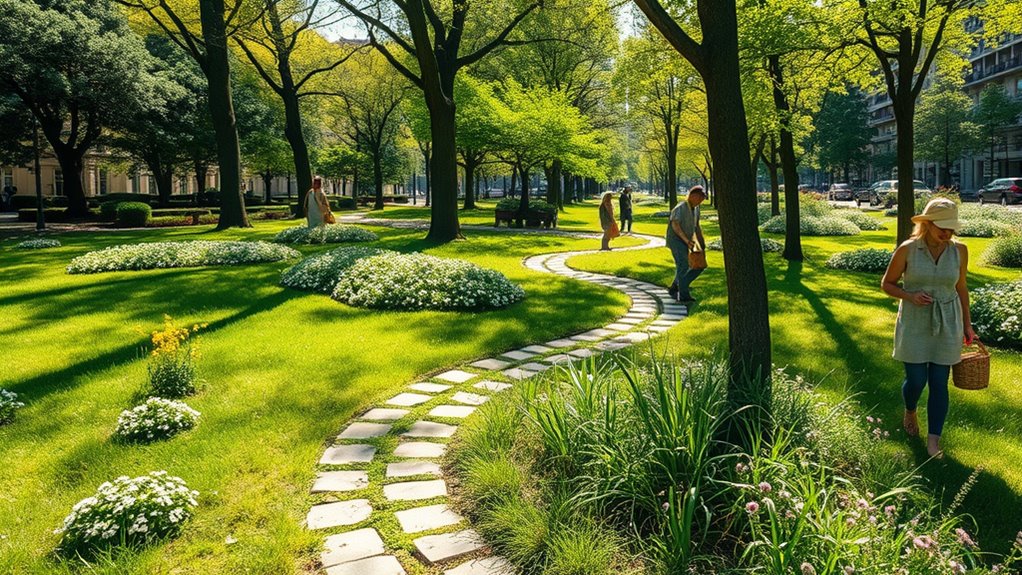
Have you considered how sustainable harvesting practices can safeguard urban plant populations and guarantee your foraging efforts remain beneficial? Practicing good urban foraging ethics means only taking what you need and avoiding overharvesting. Incorporate composting methods to recycle plant scraps, enriching soil and supporting healthy plant growth nearby. This reduces waste and promotes a balanced ecosystem within the city. Respect plant life by not damaging roots or stems, and leave enough behind for the plants to regenerate naturally. Being mindful of your impact helps preserve the urban environment for future foragers and local wildlife. Using appropriate tools and techniques ensures efficient and safe harvesting while minimizing disturbance. By following these sustainable practices, you contribute to a healthier, more resilient cityscape while enjoying fresh, wild edibles responsibly.
Avoiding Contaminants and Polluted Areas
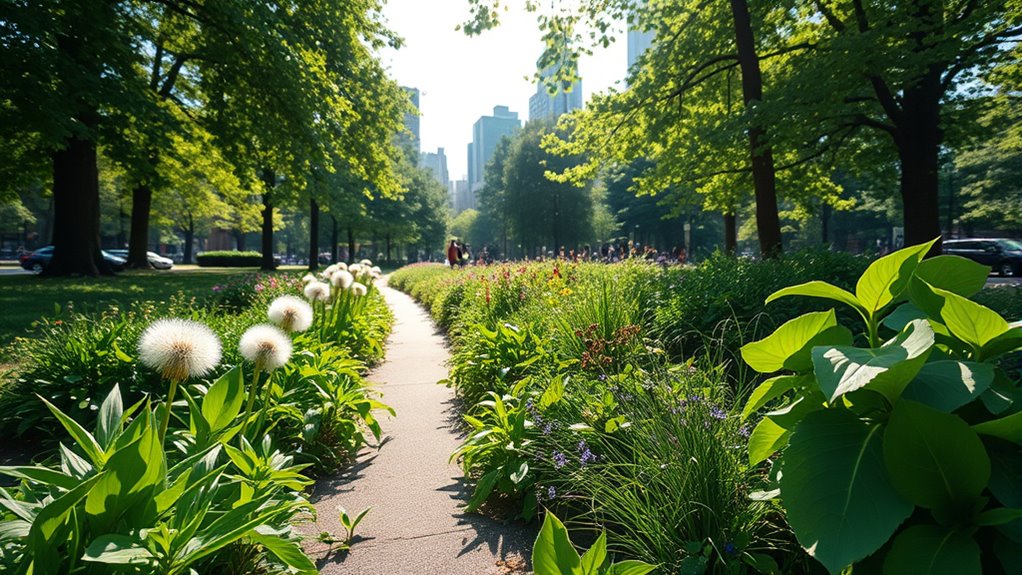
While practicing sustainable harvesting helps protect urban plant populations, it’s equally important to be aware of environmental contaminants that can pose health risks. Pollution hotspots and soil contamination can introduce harmful toxins into edible plants, making them unsafe to eat. To avoid these dangers, steer clear of areas near busy roads, industrial zones, or old construction sites. Be mindful of signs indicating pollution or recent chemical spills. Remember, plants growing in contaminated soil can absorb pollutants, which then settle in your body when consumed. Additionally, understanding signs of spoilage in plants and produce can help you identify unsafe food sources.
Creative Ways to Prepare and Enjoy Urban Edibles
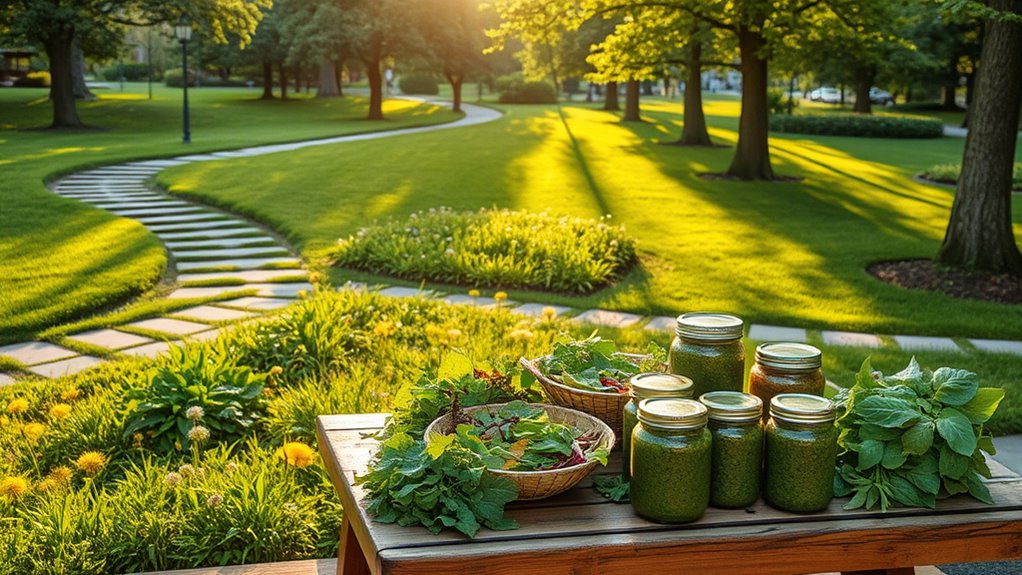
Discovering fresh urban edibles is just the beginning; the real fun starts with exploring creative ways to prepare and enjoy them. Bust urban foraging myths by understanding that many plants are safe when correctly identified and handled. Get inventive—try making pesto with wild greens, adding edible flowers to salads, or blending berries into smoothies. Emphasize plant foraging ethics by harvesting sustainably: take only what you need, avoid overharvesting, and always leave enough for wildlife and future foragers. Don’t assume all plants are edible or safe without proper knowledge; misinformation can be risky. Instead, experiment with simple recipes that highlight fresh flavors, and share your culinary creations with friends. Embracing these practices makes urban foraging both safe and delicious, turning city parks into your personal farm-to-table source.
Legal Considerations and Respecting Public Spaces
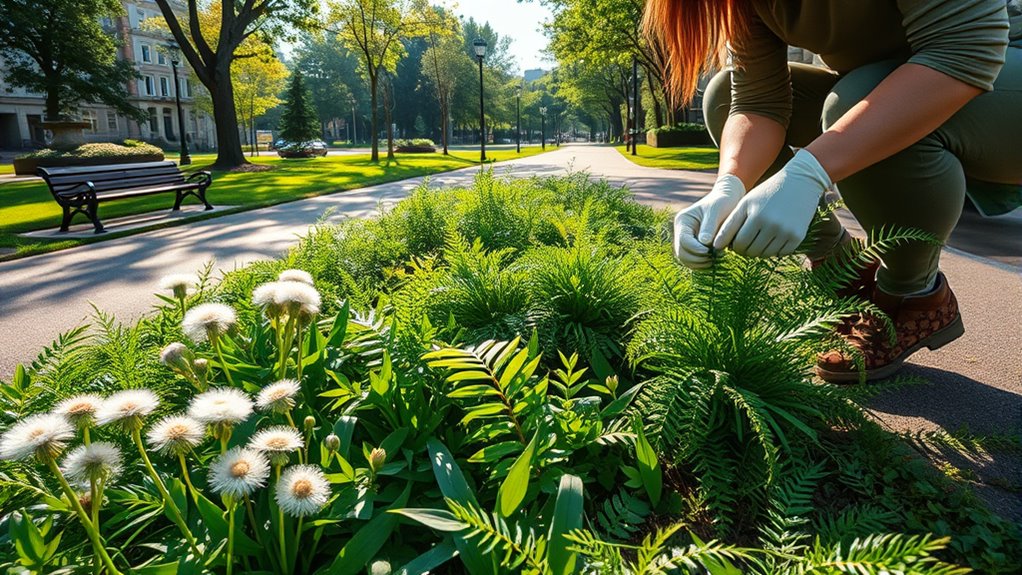
Exploring urban foraging responsibly requires understanding the legal landscape and respecting public spaces. Always check park regulations before gathering plants, as rules vary by location. Be aware of trespassing laws; don’t venture into private property without permission. Respect signage and designated areas to avoid conflicts. Remember, your foraging should preserve the environment and community trust.
- Feel the thrill of discovering edible plants, but stay within legal boundaries to protect your passion.
- Respect the hard work of park staff who maintain these spaces for everyone’s enjoyment.
- Preserve the beauty of public parks by avoiding overharvesting, ensuring others can experience urban foraging too.
- Protect your access to these green treasures by following laws and guidelines carefully.
Frequently Asked Questions
Are There Specific City Regulations on Foraging in Public Parks?
You should check your city’s park regulations before foraging, as rules vary widely. Many parks prohibit foraging without a permit, and some have designated areas for collecting plants. It’s best to contact local authorities or park management to find out if you need a foraging permit. Respect these regulations to avoid penalties, and always forage sustainably to protect the ecosystem and ensure future access.
How Can I Distinguish Between Edible and Toxic Plants Quickly?
Did you know that misidentifying plants can cause serious poisoning? When plant identification, you should look for distinct features like leaves, stems, and flowers. Use a field guide or app for quick reference, and consider toxin testing kits for extra safety. Always start with small amounts and double-check before consuming. This way, you can enjoy foraging safely and confidently in your city park.
What Safety Precautions Should I Take When Sampling New Plants?
When sampling new plants, prioritize safety by practicing proper plant identification and being allergy-aware. Always double-check with reputable guides or experts before eating anything unfamiliar. Start with a small taste to test for reactions, and avoid plants with unclear identification or signs of toxicity. Keep an allergy alert, especially if you’re prone to plant allergies, and wash your hands afterward. These precautions help you forage safely and enjoy your urban wild edibles.
How Do Urban Pollutants Affect the Safety of Foraged Foods?
Ironically, urban pollutants make foraging riskier than you’d think. Soil contamination and air pollution can seep into plants, posing serious health hazards. You might find edible greens, but they could harbor toxins from heavy metals or airborne pollutants. Always test soil and avoid plants near busy roads or industrial areas. Urban foraging isn’t just about finding food; it’s about ensuring that what you pick is truly safe.
Can Foraging Negatively Impact Local Ecosystems or Wildlife?
You might wonder if foraging harms ecosystems. When you harvest plants irresponsibly, you cause ecological disturbance and plant habitat disruption, which can threaten local wildlife and plant populations. Overharvesting or trampling can damage delicate habitats, reducing biodiversity. To avoid negative impacts, forage sustainably by taking only what you need, respecting protected areas, and learning about native species. This way, you help preserve the ecosystem’s health while enjoying urban foraging.
Conclusion
Urban foraging lets you discover fresh, local edibles right in your city park. Did you know that cities can host over 200 edible plant species? By learning to identify safe plants and practicing sustainable harvesting, you can enjoy nutritious greens, berries, and herbs without harming your environment. Always stay aware of contamination risks and respect public spaces. Embrace urban foraging as a fun, eco-friendly way to connect with nature and enhance your meals.

